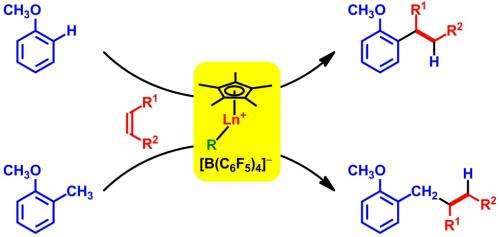'Half-sandwich' rare-earth catalysts provide unprecedented directional control over aromatic insertion reactions

Methoxybenzene, commonly known as 'anisole' because of its aniseed aroma, is an important compound in organic chemistry. Anisole-type frameworks are found in numerous molecules ranging from pheromones to fluorescent dyes. New findings from Zhaomin Hou and colleagues from the Organometallic Chemistry Laboratory at the RIKEN Advanced Science Institute now promise to make the construction of these substances more efficient thanks to unique rare-earth catalysts that direct synthetic reagents to specific sites on anisole rings.
One of the simplest ways to modify anisole molecules is through a process known as 'C–H alkylation', where a metal catalyst approaches the methoxy–ether group of the anisole and activates a carbon–hydrogen bond on the aromatic ring. After the metal bonds to the activated position, unsaturated reagents, such as double-bonded alkenes, can insert themselves into this bond, producing an anisole with a new alkyl substituent. Although promising, this procedure has had mixed success thus far due to the weak interactions between metals and the anisole, which results in the generation of a mixture of possible products.
Hou and his team took a different approach to this problem by using 'half-sandwich' rare-earth complexes to catalyze the C–H alkylation. They recently discovered that these distinctly shaped compounds, which contain elements like scandium and yttrium, could polymerize olefins with high efficiency. A key step in this polymerization involved selective alkene insertion into metal–carbon bonds—a process the researchers anticipated could be reproduced with anisole reagents.
The team first attempted the C–H alkylation with a neutral rare-earth complex to encourage the initial activation step. However, this catalyst could not promote the critical alkene insertion step. By switching to a cationic half-sandwich complex—a positively charged material with high affinity for alkenes—the researchers were successful in attaching a new alkyl group to the anisole ring.
The rare-earth complex also proved exceptionally adept at controlling product selectivity. Experiments with several alkene reagents and anisole derivatives revealed that alkylation occurred at a single specific location on the aromatic ring, and the rare-earth catalyst continued to promote alkylation at this site even if already occupied by a methyl substituent.
Hou notes that this site selectivity for anisole alkylation arises from the strong affinity of rare-earth metals towards oxygen. This interaction directs the initial coordination of the catalyst to the anisole, as well as subsequent alkene insertion, to proceed in a specific orientation. The team continues to investigate further applications of this novel process.
More information: Oyamada, J. et al. Regioselective C–H alkylation of anisoles with olefins catalyzed by cationic half-sandwich rare earth alkyl complexes. Angewandte Chemie International Edition 51, 12828–12832 (2012). dx.doi.org/10.1002/anie.201206233
Nishiura, M. et al. Novel polymerization catalysts and hydride clusters from rare-earth metal dialkyls. Nature Chemistry 2, 257–268 (2011). dx.doi.org/10.1038/nchem.595
Journal information: Angewandte Chemie International Edition , Nature Chemistry
Provided by RIKEN



















